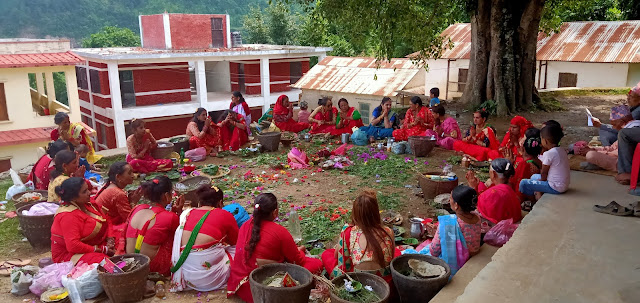Rishi Panchami Date, Importance And Other Facts 2020
- Get link
- X
- Other Apps
" The fragrance of flowers spreads only in the direction of wind but the goodness of people spreads in all direction." -Chanakya
What is Rishi panchami?
"Rishi" means sage and "panchami" means fifth day. It is celebrated on fifth lunar day of shukla paksh on the month of Bhadrapad, as per hindu calendar(lunar calendar).It falls on very next day of Ganesh chaturthi. This year Rishi panchami falls on 7th Bhadra 2077 according to Bikram sambat and 23rd August 2020 according to gregorian calendar.
It is believed that fasting on Rishi Panchami day is salutary to one and all but this expeditious is more concretely visually examined by the women. The festival of Rishi Panchami is a woman's way of expressing devotion, gratefulness, faith and reverence towards one's husband. Fasting on this festival can ravage the sins which one has committed unknowingly.
What is the purpose of fasting and importance of the day?
As per the Hindu tradition, women who are experiencing menstruation or period are verboten to undertake religious activities or involve themselves in domestic works (including kitchen work) till they are in that state. They are even enjoined to physically contact things cognate to religion. If this requisite has been breached by mistake or due to other reasons, it leads to Rajaswala Dosh among the women who have contravened this norm. Women expeditious on Rishi Panchami to dispense this dosh.
Rishi Panchami is also known as Bhai Panchami. Sisters tie rakhis to brothers on this day in the Maheshwari community. Sisters fast on this day and pray for their brother's long life. They consume food only after performing the puja.
What is the story behind the Rishi panchami?
As per the tradition, there once lived a Brahmin named Uttak with his devoted wife in Vidarbha country. The Brahmin was having a son and a daughter. He espoused his daughter to a cultured Brahmin man but the girl's husband met with an untimely death, rendering the girl to lead the life of a widow. She came back to her father's place and commenced residing there again. Some days later, the girl got worms all over the body. It engendered quandaries(problems) for her. This worried her parents, who visited a Rishi to seek a solution to the quandary.
The enlightened Rishi peeped into the past lives of the Brahmin's daughter. Rishi told the Brahmin and his wife that their daughter had breached a religious rule in her past life. She had physically contacted some kitchen utensils while she was in the menstruation. Thus, she had invited the sin which was getting reflected in her present birth. It is verbalized in the holy scriptures that a woman who is in the menstruation should not physically contact religious things and kitchenware. Rishi further told them that the girl had not optically canvassed the Rishi Panchami Vrat, that is the reason why she had to face these consequences.
The Rishi withal told the Brahmin that if the girl undertakes the Rishi Panchami expeditious with full faith and devotion and seeks forgiveness for her sins, she will dispense her past actions (karma) and become free of the worms on her body. The girl did what she was told by her father and she got free of the worms.
What are the Poooja bidhi and other rituals to be undertaken?
Women and girls take bath on holy rivers and other water masses and wear clean and religiously pure clothes. The custom and ritual dedicated to Rishi panchami must be performed with pure heart and dedication. A person's intention plays a great role in purification of soul. A fast is observed by women and girls on the day of Rishi panchami. The one and only purpose of Rishi panchami is to sanctify the person completely. Therefore people do many things like cleaning teeth with upmarga(herb) and bathing with datwan herb.These herbs are very pure and are considered to clean the body well. Herbs are used for outer purification whereas a mixture of curd,basil,butter,milk is drunk to purify the soul.
Lord Ganesh, saptarishis, navagraha(nine planet), and Arundathi(wife of vashistha).The name of saptarishis are Kashyap, Atri, Bharadwaja, Vishvamitra, Gautama maharishi, Jamadagni and Vashishta. In this vrata, the people express veneration, gratitude and remembrance of the great deeds of those antediluvian Rishis, who devoted their life for the welfare of the society. The expeditious is to be optically canvassed by women.
Women create and place the image of SaptaRishi (the seven sages) on the Mandal. Pour pure water and Panchamrut over the image. Do their tika using sandalwood (Chandan). Put on a garland of flowers and offer flowers to the SaptaRishi. Make them wear the sacred thread . Offer then white clothes. Also offer them fruits, sweets, etc. Put incense etc at the place. In several regions, this process is undertaken on the river bank or near a pond or near temple. Women don't consume cereals after this puja. Rather they consume a special type of rice on Rishi Panchami.
What is the significance of this fasting and ritual?
In this vrat, the people express veneration, gratitude, and remembrance of the great deeds of those antediluvian Rishis, who devoted their lives to the welfare of the society. This expeditious is the destroyer of sins and is worth-rewarding; if it was done by an opportune set of traditional rituals. Rishi Panchami festival forms a consequential substratum for fasting and pays reverence gratitude, dedication, and reverence towards the rishis; which designates seven sages and to get purified from Rajaswala Dosha. This expeditious is more famous in Nepali Hindus. In some regions three days Haritalika Teej fasting ends on Rishi panchami.
-Nama Raj Bhusal
Beginning of new era to change the world via words.
- Get link
- X
- Other Apps
Comments



😍👌
ReplyDeletebeautiful kanxa lekhai
ReplyDeleteKeep on writing😍
ReplyDelete😍😍👌♥️
ReplyDeletethank you
DeleteAwesome 👍♥️👍
ReplyDeletethank you
DeleteNice information keep it up 👍 वो
ReplyDeleteBro
Thank you
DeleteAppreciable work
ReplyDelete